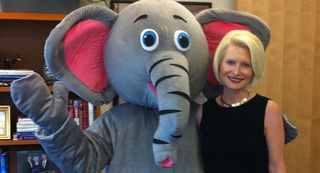A Bangladeshi woman weeps as she holds a picture of
her and her missing husband as she waits at the site of a building that
collapsed Wednesday in Savar, near Dhaka, Bangladesh, Friday, April 26,
2013. The death toll reached hundreds of people as rescuers continued to
search for injured and missing, after a huge section of an eight-story
building that housed several garment factories splintered into a pile of
concrete.
As Bangladesh reels from the deaths of hundreds
of garment workers in a building collapse, the refusal of global
retailers to pay for strict nationwide factory inspections is bringing
renewed scrutiny to an industry that has profited from a country
notorious for its hazardous workplaces and subsistence-level wages.After a factory fire killed 112 garment workers in November, clothing
brands and retailers continued to reject a union-sponsored proposal to
improve safety throughout Bangladesh’s $20 billion garment industry.
Instead, companies expanded a patchwork system of private audits and
training that labour groups say improves very little in a country where
official inspections are lax and factory owners have close relations
with the government.
In the meantime, the number of deaths and injuries has mounted. In
the five months since last year’s deadly blaze at Tazreen Fashions Ltd.,
there were 40 other fires in Bangladeshi factories, killing nine
workers and injuring more than 660, according to a labour organization
tied to the AFL-CIO umbrella group of American unions. Manufacturers
dispute that there have been that many recent incidents.
Wednesday’s collapse of the Rana Plaza building that killed more than
300 people is the worst disaster to hit Bangladesh’s fast-growing and
politically powerful garment industry. For those attempting to overhaul
conditions for workers who are paid as little as $38 a month, it is a
grim reminder that corporate social responsibility programs are failing
to deliver on lofty promises.
More than 48 hours after the eight-story building collapsed, some
garment workers were still trapped alive Friday, pinned beneath tons of
mangled metal and concrete. Rescue crews struggled to save them, knowing
they probably had just a few hours left to live, as desperate relatives
clashed with police.
“Improvement is not happening,” said Amirul Haque Amin, president of
the National Garment Workers Federation in Bangladesh, who said a total
of 600 workers have died in factory accidents in the last decade. “The
multinational companies claim a lot of things. They claim they have very
good policies, they have their own code of conduct, they have their
auditing and monitoring system,” Amin said. “But yet these things keep
happening.”
What role retailers should play in making working conditions safer at
the factories that manufacture their apparel has become a central issue
for the $1 trillion global clothing industry.
The clothing brands say they are working to improve safety, but the
size of the garment industry — some 4,000 factories in Bangladesh alone
—means such efforts skim the surface. That opaqueness is further muddied
by subcontracting. Retailers can be unwittingly involved with
problematic factories when their main suppliers farm out work to others
to ensure orders are filled on time.
“We remain committed to promoting stronger safety measures in
factories and that work continues,” Wal-Mart said in a statement after
the Rana Plaza collapse. The world’s largest retailer says there was no
authorized Wal-Mart production in the building. One of the Rana Plaza
factories, Ether Tex, listed Wal-Mart as a customer on its website.
Labour groups argue the best way to clean up Bangladesh’s garment
factories already is outlined in a nine-page safety proposal drawn up by
Bangladeshi and international unions.
The plan would ditch government inspections, which are infrequent and
easily subverted by corruption, and establish an independent
inspectorate to oversee all factories in Bangladesh, with powers to shut
down unsafe facilities as part of a legally binding contract signed by
suppliers, customers and unions. The inspections would be funded by
contributions from the companies of up to $500,000 per year.
The proposal was presented at a 2011 meeting in Dhaka attended by
more than a dozen of the world’s largest clothing brands and retailers —
including Wal-Mart, Gap and Swedish clothing giant H&M — but was
rejected by the companies because it would be legally binding and
costly.
At the time, Wal-Mart’s representative told the meeting it was “not
financially feasible … to make such investments,” according to minutes
of the meeting obtained by The Associated Press.
After last year’s Tazreen blaze, Bangladeshi union president Amin
said he and international labor activists renewed a push for the
independent inspectorate plan, but none of the factories or big brands
would agree.
Siddiqur Rahman, former vice-president of the Bangladesh Garment
Manufacturers and Exporters Association, denied the factories are
responsible for killing the plan, saying the problem was that buyers did
not want to pay for it.
“We welcome anything that is good for the garment industry and its
workers here,” Rahman said. He also disputed several union groups’
figures of dozens of factory fires since November, saying there had been
only one.
This week, none of the large clothing brands or retailers would comment about the proposal.
Wal-Mart spokesman Kevin Gardner did not directly answer questions
about the unions’ safety plans in replies to questions emailed by The
Associated Press. H&M responded to questions with emailed links to
corporate social responsibility websites.
In December, however, a spokesperson for the Gap — which owns the
Gap, Old Navy and Banana Republic chains — said the company turned down
the proposal because it did not want to be vulnerable to lawsuits and
did not want to pay factories more money to help with safety upgrades.
H&M also did not sign on to the proposal because it believes
factories and local government in Bangladesh should be taking on the
responsibility, Pierre Börjesson, manager of sustainability and social
issues, told AP in December.
H&M, which places the most apparel orders in Bangladesh and works
with more than 200 factories there, is one of about 20 retailers and
brands that have banded together to develop training films for garment
manufacturers.
Wal-Mart last year began requiring regular audits of factories, fire
drills and mandated fire safety training for all levels of factory
management. It also announced in January it would immediately cut ties
with any factory that failed an inspection, instead of giving warnings
first as before.
And the Gap has hired its own chief fire inspector to oversee factories that produce its clothing in Bangladesh.
But many insist such measures are not enough to overhaul an industry that employs 3 million workers.
“No matter how much training you have, you can’t walk through flames
or escape a collapsed building,” said Ineke Zeldenrust of the
Amsterdam-based Clean Clothes Campaign, which lobbies for garment
workers’ rights.
Private audits also have their failings, she said. Because audits are
confidential, even if one company pulls its business from a supplier
over safety issues, it won’t tell its competitors, who will continue to
place orders — allowing the unsafe factory to stay open.
The Tazreen factory that burned last year had passed inspections, and
two of the factories in the Rana Plaza building had passed the
standards of a major European group that does factory inspections in
developing countries. The Business Social Compliance Initiative, which
represents hundreds of companies, said the factories of Phantom Apparels
and New Wave Style had been audited against its code of conduct which
it said focuses on labor issues, not building standards.
“The audits and inspections are too much focused on checklists,” said
Saif Khan, who worked for Phillips Van Heusen, the owner of brands
Tommy Hilfiger and Calvin Klein, in Bangladesh until 2011 as a factory
compliance supervisor.
“They touch on broader areas but do not consider the realities on the ground,” he said.






 Peter
Nonacs, professor of biology at UCLA, teaches Game Theory in his
Behavioral Ecology course. He told his students that for an upcoming
exam, they could do anything that would normally be considered cheating:
Peter
Nonacs, professor of biology at UCLA, teaches Game Theory in his
Behavioral Ecology course. He told his students that for an upcoming
exam, they could do anything that would normally be considered cheating: The
The 












 Alexander
Graham Bell worked with sound, tinkering with gadgets to help his wife,
who was deaf, communicate. He is known as the inventor of the
telephone. He gave the Smithsonian more than 400 discs and cylinders of
his audio experiments, but until recently there was no way to play them
back.
Alexander
Graham Bell worked with sound, tinkering with gadgets to help his wife,
who was deaf, communicate. He is known as the inventor of the
telephone. He gave the Smithsonian more than 400 discs and cylinders of
his audio experiments, but until recently there was no way to play them
back.














